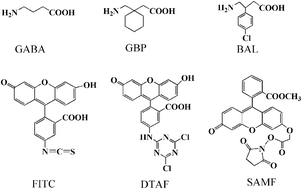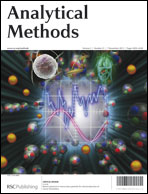Capillary electrophoresis-laser induced fluorescence detection of GABA and its analogs in human serum with solid-phase extraction and fluorescein-based probes
Abstract
Three fluorescein-based probes, fluorescein isothiocyanate (FITC), 5-(4,6-dichlorotriazinylamino) fluorescein (DTAF) and 6-oxy-(N-succinimidylacetate)-9-(2′-methoxycarbonyl) fluorescein (SAMF), were adopted for the analysis of gabapentin (GBP), baclofen (BAL) and γ-aminobutyric acid (GABA) by CE-LIF. The derivatization, separation, and analytical characteristics of three methods using the above-mentioned reagents were all carefully studied and compared. The optimal derivatization yield of SAMF was achieved in borate buffer (pH 8.0) for 15 min at 20 °C. It was demonstrated that the derivatization with SAMF is faster and simple. For SAMF, a solid-phase extraction (SPE) procedure was further developed and a SPE-CE-LIF method was resultantly established to analyze GABA and its analogs. Under optimum conditions, the analytes were baseline separated and the LODs ranged from 2 × 10−11 mol L−1 to 3 × 10−11 mol L−1 in the SPE-CE-LIF method, which were about 20 times lower than those in the CE-LIF method with SAMF as the derivatizing reagent. The newly established SPE-CE-LIF method was used for the determination of GABA and its analogs spiked into human serum.


 Please wait while we load your content...
Please wait while we load your content...